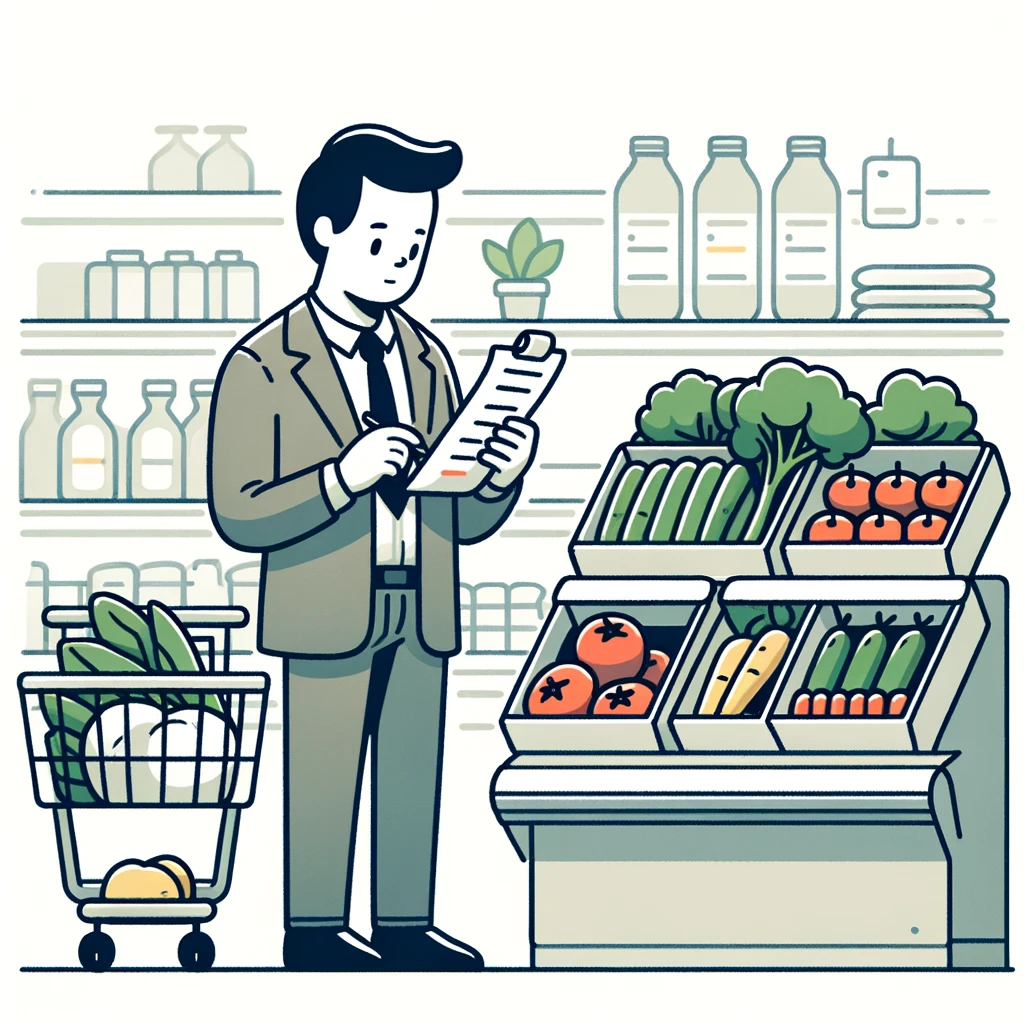Introduction
Managing finances as an individual often involves juggling various expenses, with food costs being a prominent category. Establishing a monthly food budget for one person is crucial for anyone looking to optimize their spending without compromising on nutrition or enjoyment. This blog post delves into the essentials of setting a realistic monthly food budget for one, offering practical tips and insights to help you balance your dietary needs with your financial goals. Whether you’re navigating the grocery store or planning meals for the week, understanding how to effectively manage your monthly food budget can lead to significant savings and a healthier lifestyle.
Understanding the Basics of Food Budgeting
Navigating the financial aspect of living solo brings its unique set of challenges and opportunities, particularly when it comes to managing daily expenses. A crucial element in this balancing act is developing a savvy approach to food expenditures. Understanding the basics of food budgeting is essential for anyone looking to make the most of their resources while maintaining a healthy and enjoyable diet.
What Is a Good Grocery Budget for 1 Person?
Determining a good grocery budget for one person hinges on several factors, including geographic location, dietary habits, and personal lifestyle. For instance, someone living in a city may face higher food costs compared to someone in a rural area. Similarly, dietary choices such as organic foods, special diets, or vegetarian preferences can also affect the monthly food budget. On average, a realistic monthly food budget for one might range anywhere from $200 to $400, but this can vary widely based on individual circumstances. The key is to find a figure that accommodates your nutritional needs without overstressing your finances, allowing for a balanced approach to eating well and saving money.
The Importance of Food Budgeting
The importance of creating a monthly grocery budget cannot be underestimated. Effective management of your food expenses allows you to control your financial well-being, ensuring your expenditures reflect your broader objectives. By establishing a budget, you become more conscious of your dietary selections, which can lead to healthier eating patterns and notable savings over time. Additionally, becoming proficient in managing your grocery spending aids in achieving financial stability, making additional funds available for savings, investments, or recreational pursuits. Essentially, a thoughtfully prepared food budget is fundamental not only to financial acumen but also to a lifestyle that prioritizes health and wellness.
Crafting Your Individual Monthly Grocery Plan
Formulating a monthly grocery plan for oneself is a crucial aspect of sound personal finance management. This procedure entails comprehending your earnings, regulating your expenditures, and designating an appropriate portion of your finances toward your grocery purchases. Here’s a guide on maneuvering through these steps to guarantee your grocery plan is in harmony with your economic objectives and nutritional requirements.
Step 1: Estimating Your Monthly Earnings
The initial phase in devising a monthly grocery plan for an individual is to evaluate your overall monthly earnings. This encompasses all income streams such as wages, bonuses, freelance earnings, and any other regular financial inflows. Understanding your total earnings is essential as it outlines the scope of what you can reasonably allocate to groceries each month without neglecting other fiscal duties. It offers a distinct framework for your spending limitations and aids in crafting a budget that is both feasible and sustainable.
Step 2: Subtracting Steady and Fluctuating Costs
After pinpointing your monthly earnings, the subsequent phase is to distinguish and deduct your steady and fluctuating costs. Steady costs are those that stay unchanged month over month, including expenses like housing payments, insurance premiums, and debt repayments. Fluctuating costs, conversely, may vary and encompass items like utility bills, commuting expenses, leisure, and groceries.
Deducting these costs from your overall income clarifies the amount of money available for allocation toward your individual monthly grocery plan. This step is crucial to ensure that your grocery expenditures do not impinge upon your capability to fulfill key expenses and fiscal responsibilities.
Step 3: Allocating Your Grocery Spending
With a grasp on your disposable income, you’re now prepared to establish a pragmatic grocery budget for one. This requires considering your dietary habits, food preferences, and the general pricing of groceries in your locality. An authentic monthly grocery budget for a single person should mirror your actual food consumption habits and cater to your dietary needs while adhering to your budgetary constraints.
In establishing your grocery spending, acknowledge the role of grocery budgeting in meeting your wider financial aims. Whether it’s accumulating savings for future ambitions, diminishing debt, or merely striving to live within your financial means, a meticulously planned individual monthly grocery budget can assist in judiciously managing your funds.
Incorporate strategies such as meal planning, bulk buying, and taking advantage of discounts to make the most of your grocery budget. Remember, the goal is to create a balance that allows you to enjoy nutritious, satisfying meals without overspending. Regularly reviewing and adjusting your budget based on changes in income, food prices, or dietary needs will help you maintain a sustainable and enjoyable eating lifestyle.
Strategies for Managing Your Monthly Grocery Budget for 1
Effectively managing a monthly food budget for one person requires a blend of strategic planning, smart shopping, and adaptability. By adopting a few key strategies, you can ensure that your food budget not only meets your nutritional needs but also aligns with your financial goals, providing a balanced approach to eating well and saving money.
Planning and Prioritizing Purchases
The cornerstone of a successful monthly food budget for one lies in the art of meal planning and creating detailed shopping lists. This initial step is crucial as it helps in avoiding impulse buys, ensuring that every purchase contributes to a well-balanced diet. Start by planning your meals for the week, taking into account your schedule, dietary preferences, and the ingredients you already have. This will inform your shopping list, which should prioritize nutritious, cost-effective foods that offer the best value for money.
Incorporating a variety of proteins, grains, and fresh produce, while keeping an eye out for seasonal items and sales, can make your monthly grocery budget for one person more efficient. Prioritizing purchases also means sometimes opting for frozen or canned versions of your favorite fruits and vegetables, which can be more affordable and last longer, reducing waste and stretching your budget further.
Smart Shopping Techniques
To maximize the effectiveness of your monthly food budget for one, adopt smart shopping techniques that help you get the most out of every dollar spent. Comparing prices between different stores or online platforms can lead to significant savings, especially on staple items that you buy regularly. Don’t shy away from using coupons, loyalty programs, or cashback apps that can reduce your overall spending.
Buying in bulk is another effective strategy for items with a long shelf life, such as rice, beans, and certain proteins, as it often results in a lower cost per serving. However, it’s essential to ensure you have adequate storage and will use these items before they expire to avoid waste.
Choosing versatile ingredients is also key to stretching your grocery budget for one person further. Items that can be used in multiple dishes throughout the week, such as chicken breasts, eggs, and a variety of vegetables, can reduce the need for specialized ingredients that may only be used once. This not only saves money but also simplifies meal preparation, making it easier to stick to your budget without sacrificing variety or taste.
By implementing these strategies, you can effectively manage your monthly food budget for one, ensuring that you enjoy delicious, nutritious meals that support your health and financial well-being. Remember, the goal is to find a balance that works for you, allowing for flexibility and occasional treats within the framework of your budget.
Adjusting Your Food Budget Without Sacrificing Quality
Maintaining a quality diet while adhering to a monthly food budget for one can seem challenging at first. However, with the right strategies and a bit of creativity, it’s entirely possible to enjoy nutritious, satisfying meals without overstepping your financial boundaries. Here’s how you can balance your nutritional needs with budget constraints and make smart choices that benefit both your health and your wallet.
Balancing Nutritional Needs and Budget Constraints
For those managing a monthly food budget for one, it’s crucial to find a harmony between eating well and staying within financial limits. Begin by prioritizing the purchase of versatile, nutrient-dense foods that offer the best bang for your buck. Legumes, whole grains, seasonal vegetables, and eggs are examples of affordable items that can form the basis of many healthy meals. Incorporating these staples into your diet can provide essential nutrients without a high cost.
Flexible budgeting is also key. This means allowing for adjustments in your spending from month to month based on fluctuations in your financial situation, changes in food prices, or shifts in your dietary needs. By staying adaptable, you can make necessary changes to your monthly food budget for one without compromising on the quality of your meals. For instance, if you find a great deal on a bulk purchase of chicken, you might spend more in the current month but save on your protein purchases in the long run.
The Role of Seasonal and Bulk Purchases
One effective strategy for managing your monthly food budget for one while ensuring dietary variety and freshness is to focus on seasonal and bulk purchases. Seasonal produce is often more affordable and flavorful than out-of-season counterparts shipped from afar. By aligning your meal planning with the seasons, you can enjoy a wide range of fruits and vegetables throughout the year without breaking the bank. Visiting local farmers’ markets or subscribing to a community-supported agriculture (CSA) box are great ways to access fresh, seasonal produce at a lower cost.
Bulk purchasing, on the other hand, can lead to significant savings, especially for non-perishable items like grains, nuts, and legumes, as well as frozen goods. When you buy in bulk, the price per unit typically decreases, allowing you to stretch your monthly food budget for one further. However, it’s important to only buy quantities you can realistically consume to avoid waste. Planning your meals around these bulk and seasonal purchases can help ensure that you’re eating a varied and nutritious diet while adhering to your budget.
By applying these strategies—balancing your nutritional needs with budget constraints and taking advantage of seasonal and bulk buying opportunities—you can adjust your monthly food budget for one without sacrificing the quality or enjoyment of your meals. This approach not only supports your financial goals but also encourages a healthy, diverse diet that can adapt to your evolving needs and preferences.
Tools and Resources to Track Your Monthly Food Budget for 1
In the current era of technology, a wide array of tools and resources exist to assist people in overseeing their finances, including their monthly budget for food. Utilizing these aids can streamline the budgeting process, facilitating easier monitoring of expenses, pinpointing opportunities to save money, and enabling more educated choices regarding food buying.
Utilizing Budgeting Apps and Tools
For those looking to keep a close eye on their monthly food budget for one, budgeting apps and tools offer a convenient solution. These digital platforms are designed to help you monitor your spending patterns, categorize expenses, and set budgeting goals with ease. By inputting your income and expenses, including all food-related purchases, you can gain valuable insights into where your money is going and identify areas for adjustment.
Numerous budgeting applications include functionalities like tracking receipts, notifications on spending, and tailored fiscal guidance, proving to be especially beneficial for those overseeing their individual grocery budgets. Several well-regarded apps facilitate the linking of checking accounts and credit card details, presenting an instantaneous snapshot of your financial status and the way your monthly grocery expenditure aligns with your broader financial activities.
Choosing the right budgeting tool depends on your specific needs and preferences. Look for apps that offer customization options, allowing you to tailor your budget categories and goals to reflect your monthly food budget for one. Additionally, consider the security features of the app, as you’ll be sharing sensitive financial information.
Utilizing these budgeting apps and tools can significantly enhance your ability to manage your monthly food budget effectively. By providing a clear overview of your spending and offering actionable insights, these digital resources can help you make smarter food purchasing decisions, ensuring that you stay within budget without compromising on the quality or variety of your meals. With the right tool in hand, mastering your monthly food budget for one becomes not just a goal, but an achievable reality, paving the way for financial stability and a healthier lifestyle.
Real-Life Examples of a Monthly Food Budget for 1
Navigating the nuances of a monthly food budget for one can vary widely from person to person, influenced by factors like dietary preferences, geographical location, and financial goals. Exploring real-life examples provides valuable insights into the practical application of budgeting strategies, demonstrating how individuals can successfully manage their food expenses. Below, we highlight several anonymized case studies that showcase the diverse approaches to maintaining a monthly food budget for one.
Case Study 1: The Urban Professional
In a bustling city where the cost of living is high, an urban professional manages to keep their monthly food budget for one within $250. By planning meals around weekly sales at local grocery stores and prioritizing the purchase of seasonal produce, this individual maximizes savings without compromising on nutrition. They allocate their budget across various food groups, with a focus on plant-based proteins and whole grains, which are both cost-effective and nutritious. Eating out is limited to once a month, with the emphasis placed on enjoying experiences rather than making it a routine.
Case Study 2: The College Student
A college student living in a dorm has set a monthly food budget for one at $150, leveraging meal planning and bulk buying to stretch their dollars. They focus on purchasing versatile ingredients like rice, beans, and frozen vegetables, which can be used in multiple dishes throughout the week. Additionally, by participating in a local food co-op, the student accesses fresh produce at lower prices. Cooking in batches and utilizing leftovers for subsequent meals helps minimize waste and ensure that the budget is adhered to.
Case Study 3: The Freelancer
Working from home, a freelancer has more flexibility to prepare meals, setting a monthly food budget for one at $200. They invest in a slow cooker, allowing them to make cost-effective, hearty meals that last for several days. By carefully tracking spending through a budgeting app, the freelancer identifies patterns and adjusts their grocery shopping habits to avoid overbuying. They also take advantage of farmers’ markets later in the day, purchasing produce at reduced prices to use in creative recipes.
Case Study 4: The Health-Conscious Individual
For someone focusing on a health-conscious diet, maintaining a monthly food budget for one might seem daunting due to the higher cost of organic and specialty foods. However, by setting a budget of $300 and sticking to it through meticulous planning and smart shopping, this individual manages to balance their dietary needs with financial limitations. They prioritize the bulk purchase of organic grains and legumes and choose locally sourced fruits and vegetables. Additionally, by preparing most meals at home and limiting the purchase of processed foods, they enjoy a nutritious diet that aligns with both their health goals and budget.
Strategies and Adjustments
These case studies illustrate the importance of adaptability and strategic planning in managing a monthly food budget for one. Common strategies include meal planning, bulk buying, focusing on versatile and seasonal ingredients, and leveraging technology to track spending. Adjustments may be necessary based on changes in income, food prices, or personal circumstances, highlighting the dynamic nature of budgeting. Each individual’s approach to their monthly food budget for one reflects their unique lifestyle and priorities, demonstrating that with the right strategies, maintaining a balanced and enjoyable diet on a budget is entirely achievable.
Final Thoughts on Crafting a Monthly Food Budget for 1
The Benefits of Consistency and Adjustment
Maintaining a monthly food budget for one is not just about meticulous planning and strategic shopping; it’s a continuous journey of self-awareness and adjustment that reflects our ever-changing financial circumstances and dietary preferences. The journey towards mastering a monthly food budget for one person is paved with the insights gained from regular review and the willingness to adapt to meet your evolving needs and goals.
A primary lesson learned from setting up a monthly budget for personal food expenses is its significant influence on your financial wellness. Allocating a portion of your time monthly to examine how your spending aligns with your budget, and making adjustments where needed, helps keep your food costs in line with your overall financial goals. This routine process of scrutiny and modification deepens your insight into your expenditure habits, enabling you to make choices that benefit your economic and health status.
Moreover, the practice of regularly revisiting your monthly food budget for one encourages a flexible approach to financial planning. Life is full of unexpected changes, from fluctuating food prices to shifts in dietary needs or personal goals. By embracing the need for occasional budget adjustments, you can navigate these changes without compromising the quality or enjoyment of your meals. This adaptability is crucial in maintaining a balanced and enjoyable diet, even when faced with financial constraints.
Crafting and maintaining a monthly food budget for one is a dynamic process that requires commitment, consistency, and the flexibility to adapt to life’s changes. The benefits of this approach extend far beyond mere financial savings. By embracing the discipline of regular review and adjustment, you can achieve a harmonious balance between enjoying nutritious, satisfying meals and achieving your long-term financial goals. This balance is the cornerstone of a healthy, financially stable lifestyle, proving that with the right strategies and mindset, managing a monthly food budget for one can be both rewarding and transformative.
Conclusion
Creating and sticking to a monthly food budget for an individual is crucial for anyone looking to effectively balance their dietary preferences with their budgetary limits. This approach goes beyond just cutting costs; it’s about enhancing the value and satisfaction gained from each meal. Through careful planning of your grocery purchases, making choices based on knowledge, and leveraging digital tools for tracking expenditures, you can confirm that your food expenses are in harmony with both your health needs and financial objectives. This methodical yet adaptable strategy for budget management enables you to sustain a wholesome lifestyle while setting the stage for financial wellbeing and autonomy, demonstrating that with prudent oversight, a monthly food budget for one can yield considerable savings without compromising on quality or enjoyment.



